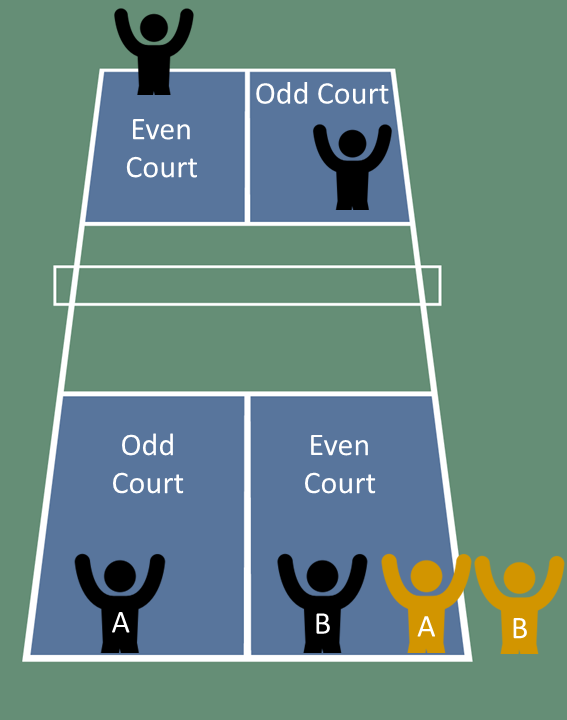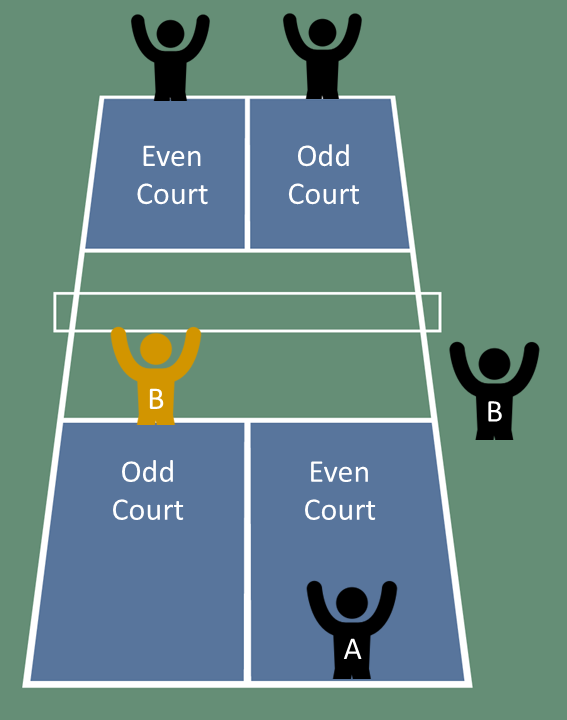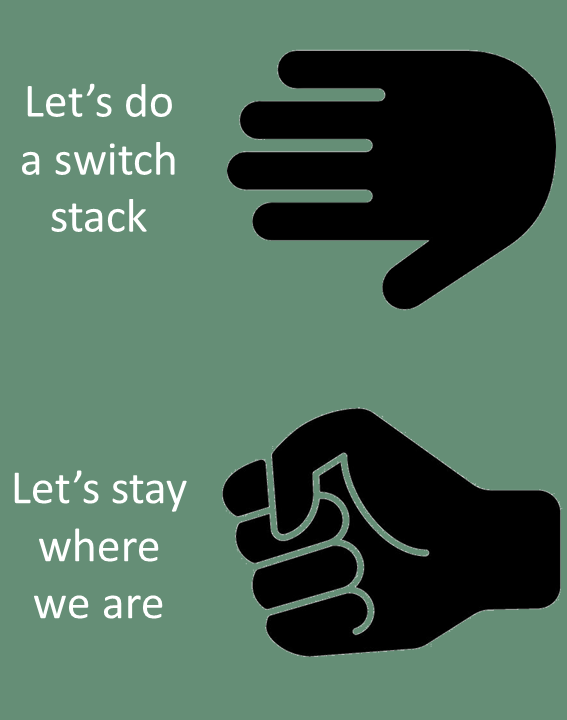Have you ever wondered why you sometimes see players stand on the same side as their teammate during their serving? Or, when you see players switch sides after returning a serve?
What they are doing is executing an advanced strategy called “stacking”, which has become quite common for teams at the amateur and pro levels. Successfully switching sides at the start of a rally (whether serving or receiving) allows players to play one side of the court for the majority of the match.
With this intention, players can then really play to their strengths, protect their weaknesses and/or expose the opponent’s weaknesses, which during competition, is often the main goal.
This strategy was more commonly used in mixed doubles but as of late, is also being used in doubles (men's/women's) and, when done correctly, stacking can be a great way for a team to fully utilize their strengths or poke larger holes into the opponent’s weaknesses.
Let's dive in...
-Dec-22-2022-09-54-13-9606-AM-1.png?upscale=true&width=644&upscale=true&name=unnamed%20(1)-Dec-22-2022-09-54-13-9606-AM-1.png)
Photo credit: Pickleball Fire
Stacking During Serve
Sacking on serve means that as the serving team scores points, instead of switching sides with the partner, the players slide or stack to one side of the court so that the server is in the correct court positioning.
In the image below you can see that “A” is serving on the right (or even) side of the court, standing beside their partner “B”. After “A” serves, they will immediately slide over to cover the left side of their court.
Shifting on A's Even Serve

Stacking as Receivers
Let’s keep the image above and the scenario in our head; team “A” and “B” did not win that rally and there is a side out and we know that player “A” served from the even court and then slid to the odd court to play out the rest of the rally.
Because they used both their serves, player “A” must then be the receiver in the even court when their opponent serves. If “B” receives the ball a “receiver's fault” is called and a point would be awarded to the other team.
But in the case that “A” knows to receive and “B” would be standing at the non-volley line or on the outer right side of the court (as seen in the image, “B” has two options). “B” has the responsibility of getting to the even court and “A” must get themselves to the odd court.

Generally, this concept is perceived as being complicated or intimidating, especially to newer players who are busy learning all of the other intricacies of the game, but with time and practice, the benefits of stacking will pay off.
Early on, it’s best to work on gaining consistency of the basics and then look to add on advanced strategies and tactics.
Righty vs Lefty
So, a scenario where it might be more beneficial to learn stacking right away is when a right-handed and a left-handed player team up.
The obvious preference will likely be to keep both of their forehands in the middle of the court, so the ideal configuration is that the leftie plays the right side and the righty plays the left side (except for serve and return). To position themselves in the reverse order, that team will be exposing their backhands in the highest percentage part of the court.
Not only is stacking becoming increasingly popular amongst top players but it is becoming more common for players to identify themselves - or others see others - as right or left-side players.
In our Pro Series articles, I ask each pro if they identify as a right or left-side player - of course, some do and some don’t. The lefties always identify as a right-side player.
So, what seems to be happening amongst the pros is that they are considering side strengths when choosing to team up with another player - of course, any player wants to match up with someone else who can complement their own game - but now which side one plays has become a consideration.
The most obvious example of a recognizable team that stack pretty much 100% of the time is the sibling duo, Ben and Colin Johns. The two seem to have self-identified themselves as left and right players.
Colin is a consistent player who sets up his brother by playing the right side and creates the opportunity for Ben to the put-away middle, forehand shots. Ben controls the left side, he has perfected the disguised backhand roll so well that it looks like a backhand dink.
Ben has great awareness of what ball to attack and when, while playing the left side. There really can be a huge advantage to increasing specific skills when you only really focus on playing one side.
Further Explanation
Teams can choose to fully stack or half stack. Full stack means the team will do so on their serve and when the opponents are serving. Half stack means a team will stack only when serving, not while receiving.
A common reason for this is to prevent getting caught having to switch during a return (possible mobility issues, the serve is too good and doesn’t leave enough time to make the switch effectively).
My recommendation is that if you and your teammate are getting confused about where to go, and mixing up the positioning, to just stop stacking for that game.
Stacking on A's Even Return of Serve

Communication
Partners who stack all of the time don’t need to clarify between points, or check in with one another. However, for receiving teams who partially stack or decide to implement it mid-match, hand signals are the common form of communication.
The person standing at the non-volley line will signal to their teammate what they prefer to do that play and the player at the baseline waiting to receive will confirm. Typically, an open hand showing all five fingers means “switch sides” and a closed hand means “stay”.

My Own Experience with Stacking
About three years into playing is when I first started to teach myself how to stack and it was hard to keep track of proper positioning. I only practiced during rec games until I felt comfortable enough to implement it in competition.
I don’t think I would have ever said yes to stacking during a tournament unless I felt 100% sure I knew what I was doing. These days I really like having the ability to stack whenever my teammate and I feel it’s necessary and I’ve also played with many people at tournaments where we stack the entire time (both mixed and women’s doubles).
I’ve played the right side and have also stacked on the left, to me, both are fun to play and I have my strengths and weaknesses on both sides.
At this point, I don’t have a clear preference, rather, with anyone who I play with, I would prefer to take the time to discuss the advantages of stacking (or not) a a team, how much we want to integrate it into our plan and how we feel about “un-stacking” if we feel that it’s becoming less effective or need to shake things up to become less predictable.
Final Thoughts
In mixed doubles you’ll often see the male starting on the right side - there are a couple of main reasons for this. The male player usually has a very powerful forehand and should the ball get sent to the middle of the court, their forehand is right there to try and finish the point.
On that same vein, there is naturally more court the person on the left side can cover because they (as a right-handed player) can lean right and step in to take some of the balls that land closer to the center line.
It’s very common in mixed for the woman to get overplayed, again, the stronger player having their forehand in the middle will help support the player on the right side who is receiving the majority of the shots.
For anyone who’s been involved in the game for a few years, we know that pickleball is still very much evolving and is a game of smarts; despite the small court and the simplicity of the game, people are becoming more and more creative as the sport develops.
The competition is only getting stronger as more players come into the sport and players will need to be strategic in utilizing their strengths to their team’s advantage. Stacking is simply one of those tactics that can create smarter pickleball.
Before inserting this strategy into your game, it will take plenty of patience and practice, to get it down to a well-oiled machine.
Even if errors are made, it’s ok, it pretty much happens to everyone at some point, and just know that you can start or stop stacking whenever you want or need to, it just takes the two teammates to agree on it and of course, as a team, you must decide if this is a strategy you want to implement and how much of the time.
-3.png?upscale=true&width=1024&upscale=true&name=unnamed%20(3)-3.png)
Some Pros to Consider
- Can often lead to higher shot consistency
- Focus training on sides, in a way, less to think about while developing
- Teams might stack part-time when they feel it’s time to shake up the rhythm of a match or to snap themselves out of a scoring freeze
- Some teams will start stacking one way and make a change in the middle of competition, this could be one player is playing better on one side than the other, based on their competition and their own weaknesses they may find that reversing the stacking order has a higher chance of success
Some Cons to Consider
- Often after a long rally or in stressful moments of a match, players can easily forget their positioning and, as we know, if someone is in the incorrect place when serving or receiving, it is an automatic fault
- Players can get confused and forget to stack, leaving one side of the court exposed for a simple line drive from the opponent
- As receivers, if the return is shallow, it often doesn’t make sense to fully switch, throwing off the strategy right away
- If the left-side player’s third shots are off, then the team will have to try relying on the right-side player to execute the third shot on their backhand
- Most players are interested and/or able to play both sides somewhat equally and prefer it that way, but when the team elects to stack then they never get to play the other side
- A player might get used to training on one side but then has to retrain themselves if they change partners or plays right side in mixed and left side in doubles
This article was taken from our 'Control the Kitchen' Newsletter, if you're interested in receiving more content like this, please feel free to sign up using the subscribe section located at the bottom left of this page (or underneath the article if you're on mobile), thanks!